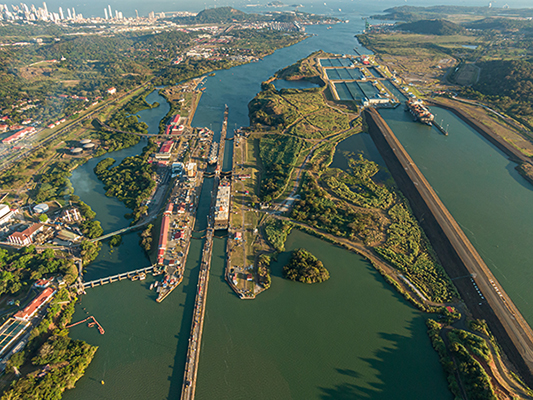The pandemic unleashed unprecedented volatility in the supply chain, and while it has mostly stabilized, storm clouds loom on the horizon.

By Steve Bassaw, Partner Enablement Manager, SYSPRO
The supply chain is finally stabilizing after the pandemic turmoil, but that doesn’t mean manufacturers and distributors can rest easy. There are significant storm clouds appearing that supply chain managers and senior leadership should keep a close eye on, especially for the second half of 2024.
Last year, my colleague Matthew Gordon-Box wrote in Industry Today that “constant disruption may be the new normal.” Thankfully, the supply chain has largely recovered from the constant volatility that COVID-19 and subsequent supply and demand shocks unleashed. For example, container ships are no longer waiting weeks to unload at ports, and shipping containers, which were still in short supply 12 months ago, are much more available. Inflation is still a concern, but it’s fallen well off its peak in mid-2022, hovering around 3.5%, which is manageable for most businesses. Average lead times for production materials is almost back down to pre-pandemic levels, and freight rates are even lower than they were in 2019!

Nevertheless, manufacturers and distributors shouldn’t become complacent, as events can quickly transform a healthy supply chain into a dysfunctional mess. Climate change is a long-term problem that has that potential. For instance, severe weather events are intensifying and becoming more common. In 2023, for example, Canada experienced its worst wildfire season on record, with 15 million hectares burning, which is nearly 5% of all of Canadian forests. Roads were closed, disrupting shipments, and air quality plummeted in Canada and the eastern U.S. The dampening effect on industry in Canada was significant, and it’s clear that these kinds of megafires are only going to become more frequent in the future.
The Panama Canal provides another example. Currently, Panama is in the midst of its worst drought in more than a century, which is a problem, because the canal depends on rainwater. The water level is so low, authorities have had to reduce the maximum loads ships can carry and slash the number of ships that can pass through daily by one-third. Panama is planning to invest more than $8 billion into sustainability projects to help ensure that the canal doesn’t run dry.
Hurricanes play havoc with shipping routes and can disrupt operations located in their path and, unfortunately, the intensity of hurricanes in the Atlantic ocean has steadily increased since 1990, according to the EPA. Ordinary storms, too, are becoming more damaging, especially with the increased frequency of “atmospheric rivers” which caused severe flooding on the U.S. West Coast over the winter.
War is another important consideration for supply chain risk. The ongoing war in Ukraine — a nation that has supplied an enormous amount of grain to EMEA along with rare earth minerals — has significantly disrupted markets. The war in Gaza threatens to expand to other nations, and the Houthis in Yemen have attacked vessels in the Red Sea, which has all but closed off a vital shipping route. Avoiding that area via alternate routes can delay shipping by up to two weeks, and if the war spreads, the impacts could become far worse.

Even in the face of the unknown, manufacturers and distributors can take measures to mitigate supply chain risk by making them more resilient and flexible. One strategy becoming popular is to shorten supply chains. The fewer links in the chain, the less likely one of them is to break. Nearshoring and “friend” shoring (which means working with highly trusted suppliers) are examples of this.
Technology can also help. AI and advanced analytics, for example, can analyze past patterns of supply and demand and incorporate additional data — weather, macro-economic, global shipping, and more — to predict customer demand and reliability of supply (e.g. late deliveries and shortages) so organizations can take proactive action. These technologies can help supply chain professionals manage complex multi-sourcing supply chains, which are difficult to manage without some kind of intelligent automation. Additionally, AI and predictive analytics can help manage inventory to keep an appropriate buffer of key components and raw materials to weather sudden shortages.
As an industry, we need to prepare now for the unexpected supply chain shocks that will inevitably come our way, this year and in the years ahead. We’ve learned how damaging it can be to take supply chain stability for granted. Extremely lean supply chains with very low inventory are efficient but can also be fragile. Prepare now so that when the next crisis hits, the effects may be difficult, but not devastating.

About the Author:
Steve Bassaw is a Partner Enablement Manager at SYSPRO Americas. Steve has been with SYSPRO for 20 years in diverse roles such as support, consulting, product management, and solution architect. Before joining SYSPRO, Steve was a SYSPRO software super-user at a manufacturing company where he gained hands-on experience using ERP to improve operations and supply chain. Steve is also chair of the advisory committee for the business/IT program at BCIT (British Columbia Institute of Technology).
In this episode, I sat down with Beejan Giga, Director | Partner and Caleb Emerson, Senior Results Manager at Carpedia International. We discussed the insights behind their recent Industry Today article, “Thinking Three Moves Ahead” and together we explored how manufacturers can plan more strategically, align with their suppliers, and build the operational discipline needed to support intentional, sustainable growth. It was a conversation packed with practical perspectives on navigating a fast-changing industry landscape.